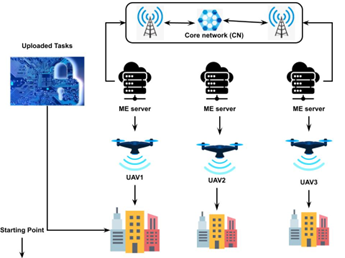5G Technology based Edge Computing in UAV Networks for Resource Allocation with Routing using Federated Learning Access Network and Trajectory Routing Protocol
Main Article Content
Abstract
UAVs (Unmanned aerial vehicles) are being utilised more frequently in wireless communication networks of the Beyond Fifth Generation (B5G) that are equipped with a high-computation paradigm and intelligent applications. Due to the growing number of IoT (Internet of Things) devices in smart environments, these networks have the potential to produce a sizeable volume of heterogeneous data.This research propose novel technique in UAV based edge computing resource allocation and routing by machine learning technique. here the UAV-enabled MEC method regarding emerging IoT applications as well as role of machine learning (ML) has been analysed. In this research the UAV assisted edge computing resource allocation has been carried out using Monte Carlo federated learning based access network. Then the routing through UAV network has been carried out using trajectory based deterministic reinforcement collaborative routing protocol.We specifically conduct an experimental investigation of the tradeoff between the communication cost and the computation of the two possible methodologies.The key findings show that, despite the longer connection latency, the computation offloading strategy enables us to give a significantly greater throughput than the edge computing approach.
Article Details

This work is licensed under a Creative Commons Attribution-NoDerivatives 4.0 International License.
References
Dinh, C. T., Tran, N. H., Nguyen, M. N., Hong, C. S., Bao, W., Zomaya, A. Y., &Gramoli, V. (2020). Federated learning over wireless networks: Convergence analysis and resource allocation. IEEE/ACM Transactions on Networking, 29(1), 398-409.
Mukherjee, A., Misra, S., Chandra, V. S. P., &Raghuwanshi, N. S. (2020). ECoR: energy-aware collaborative routing for task offload in sustainable UAV swarms. IEEE Transactions on Sustainable Computing, 5(4), 514-525.
Zhan, Y., Li, P., Qu, Z., Zeng, D., & Guo, S. (2020). A learning-based incentive mechanism for federated learning. IEEE Internet of Things Journal, 7(7), 6360-6368.
Yang, H., Zhao, J., Xiong, Z., Lam, K. Y., Sun, S., & Xiao, L. (2021). Privacy-preserving federated learning for UAV-enabled networks: Learning-based joint scheduling and resource management. IEEE Journal on Selected Areas in Communications, 39(10), 3144-3159.
Zhao, N., Liu, Z., & Cheng, Y. (2020). Multi-agent deep reinforcement learning for trajectory design and power allocation in multi-UAV networks. IEEE Access, 8, 139670-139679.
He, Y., Zhai, D., Huang, F., Wang, D., Tang, X., & Zhang, R. (2021). Joint task offloading, resource allocation, and security assurance for mobile edge computing-enabled UAV-assisted VANETs. Remote Sensing, 13(8), 1547.
Yu, Z., Gong, Y., Gong, S., & Guo, Y. (2020). Joint task offloading and resource allocation in UAV-enabled mobile edge computing. IEEE Internet of Things Journal, 7(4), 3147-3159.
Liu, X., Yu, J., Wang, J., & Gao, Y. (2020). Resource allocation with edge computing in IoT networks via machine learning. IEEE Internet of Things Journal, 7(4), 3415-3426.
He, Y., Zhai, D., Huang, F., Wang, D., Tang, X., & Zhang, R. (2021). Joint task offloading, resource allocation, and security assurance for mobile edge computing-enabled UAV-assisted VANETs. Remote Sensing, 13(8), 1547.
Hu, J., Chen, C., Cai, L., Khosravi, M. R., Pei, Q., & Wan, S. (2021). UAV-assisted vehicular edge computing for the 6G internet of vehicles: architecture, intelligence, and challenges. IEEE Communications Standards Magazine, 5(2), 12-18.
Chen, X., Liao, Y., Ai, Q., & Zhang, K. (2021, December). Joint Task Offloading and Resource Allocation for MEC Networks Considering UAV Trajectory. In 2021 17th International Conference on Mobility, Sensing and Networking (MSN) (pp. 296-302). IEEE.
Wu, W., Zhou, F., Wang, B., Wu, Q., Dong, C., & Hu, R. Q. (2022). Unmanned Aerial Vehicle Swarm-Enabled Edge Computing: Potentials, Promising Technologies, and Challenges. IEEE Wireless Communications.
Wang, K., Wang, L., Pan, C., & Ren, H. (2022). Deep Reinforcement Learning-Based Resource Management for Flexible Mobile Edge Computing: Architectures, Applications, and Research Issues. IEEE Vehicular Technology Magazine, 17(2), 85-93.
Yazid, Y., Ez-Zazi, I., Guerrero-González, A., El Oualkadi, A., &Arioua, M. (2021). UAV-enabled mobile edge-computing for IoT based on AI: A comprehensive review. Drones, 5(4), 148.
He, X., Jin, R., & Dai, H. (2021, March). Joint service placement and resource allocation for multi-UAV collaborative edge computing. In 2021 IEEE Wireless Communications and Networking Conference (WCNC) (pp. 1-6). IEEE.
Mahmood, O. A., Abdellah, A. R., Muthanna, A., &Koucheryavy, A. (2022). Distributed Edge Computing for Resource Allocation in Smart Cities Based on the IoT. Information, 13(7), 328.
Asim, M., & Abd El-Latif, A. A. (2021). Intelligent computational methods for multi-unmanned aerial vehicle-enabled autonomous mobile edge computing systems. ISA transactions.
Ben Aissa, S., & Ben Letaifa, A. (2022). UAV Communications with machine learning: challenges, applications and open issues. Arabian Journal for Science and Engineering, 47(2), 1559-1579.
Asim, M., Mashwani, W. K., Belhaouari, S. B., & Hassan, S. (2021). A novel genetic trajectory planning algorithm with variable population size for multi-UAV-assisted mobile edge computing system. IEEE Access, 9, 125569-125579.
Li, S., Hu, X., & Du, Y. (2021). Deep reinforcement learning for computation offloading and resource allocation in unmanned-aerial-vehicle assisted edge computing. Sensors, 21(19), 6499.
Laroui, M., Ibn-Khedher, H., Moungla, H., & Afifi, H. (2021, December). Autonomous UAV Aided Vehicular Edge Computing for Service Offering. In 2021 IEEE Global Communications Conference (GLOBECOM) (pp. 1-6). IEEE.
Shang, B., Poor, H. V., & Liu, L. (2022). Aerial Reconfigurable Intelligent Surfaces Meet Mobile Edge Computing. IEEE Wireless Communications.

